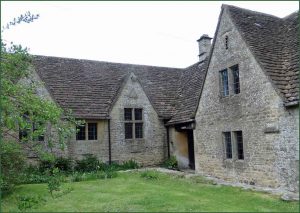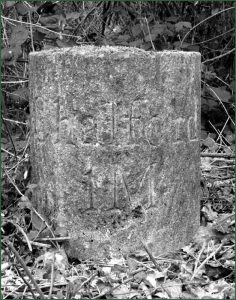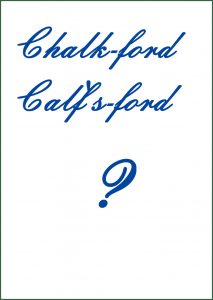15th November 2017
Arts and Crafts Architecture
Local expert Jenny Bailey drew on her long experience and extensive slide collection to talk on architecture by the local Arts and Crafts Movement. The focus was particularly on Thomas Falconer and his associates Harold Baker and John Campbell. Examples included the redesign of the Bear at Rodborough, the rear of the Subscription Rooms and the war memorials at Amberley and Nailsworth, both simple celtic crosses.
Many houses in Amberley and Pinfarthings were designed by Falconer. He designed the Wycliffe College footbridge and worked on St Alban’s Stroud where the rood screen has figures by Edward Payne, responsible for many local stained glass windows.
Jenny also showed work by other members of the group, particularly Norman Bucknell and his father Alfred, responsible for much of the local decorative metal and ironwork.
18th October 2017
Roger Carnt: Local Byways
Roger gave an interesting overview of many ancient paths and roadways in the parish. Some highlights:
– Dark Lane originally ran into the top of what is now Commercial Road, rather than continuing up
– Old Neighbourhood (an old turnpike road with the toll house at the old Noah’s Ark shop) was originally called ‘Old Neighbouring’
– The track from the A419 joining Old Neighbourhood at the Skaiteshill corner was called ‘Catchpike Lane’- with an additional toll cottage to catch people trying to evade the toll
– The link between Old Neighbourhood and Abnash was built relatively recently in 1834
– Periwinkle Lane, that runs North off Old Neighbourhood by Corpus Christi Cottage was part of an old route to Bussage
– The straight roads in the parish (e.g. Middle Hill) originate from the enclosure of Bisley Common in 1869
– Accommodation Lane has a bend at one point, to accommodate access to a specific field owned by major landowner Thomas Mills Goodlake
20th September 2017
Dr Simon Draper: Gloucestershire Place Names
The meeting started with the CPLHG AGM. Roger Carnt (Chairman) gave a report of activities, and John Dawson (Treasurer) gave a financial report – the latter was followed by a discussion of membership and admission charges. The current committee were re-elected, and a vacancy for another member advertised. (Following the meeting Tim Illot was co-opted onto the committee). A motion to amend the constitution as follows was agreed:
6. The year of the Group and membership shall run from 1st September to the ensuing 31st August.
7 c. The Group shall hold an Annual General Meeting [AGM] each year, within 8 weeks of the year end of the Group, at which the Chairman shall present an annual report and the Treasurer shall present the statement of accounts for the previous year.
Simon then gave a fascinating account of the meaning of place names, with Anglo-Saxon, Roman or Old English/Celtic roots. He said the meaning of Chalford was mostly likely to be ‘the limestone (chalk) ford’. Another example was ‘ley’ as in Horsley and Bisley from ‘leah’ a clearing in the woods for cattle or pigs to graze’; the root of Bisley and Bussage may be the same and relate to a person called ‘Bissa’, Bussage then meaning ‘Bissa’s ridge’. ‘Hyde’ refers to a farm that could support one extended family; ‘Lynch’ is a ridge or terrace on a hill. Many other examples were given and it was suggested that many were in effect ancient travellers’ way marks, to identify settlements or points on a journey (e.g. different shapes of slopes, hills, valleys, woods and watercourses).
19th July 2017
Walk along Chalford High Street
 Mike Mills led a group of local people on a walk from the bottom of Old Neighbourhood along Chalford High Street to the old Valley Inn then back along the canal towpath. We looked at old photographs to see how the buildings had changed and heard numerous stories about how people lived – from a farmer selling 250 rabbits a week, to the landlord of the New Red Lion being sacked by the brewery for doing a roaring trade in his own brew from the premises. A fascinating evening.
Mike Mills led a group of local people on a walk from the bottom of Old Neighbourhood along Chalford High Street to the old Valley Inn then back along the canal towpath. We looked at old photographs to see how the buildings had changed and heard numerous stories about how people lived – from a farmer selling 250 rabbits a week, to the landlord of the New Red Lion being sacked by the brewery for doing a roaring trade in his own brew from the premises. A fascinating evening.
12th July 2017
Visit to St Mary’s Mill
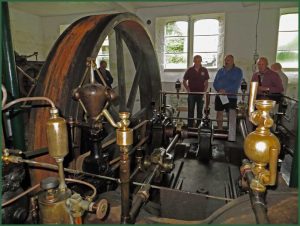 Prof. Jenny Tann gave us an excellent guided tour starting at The Round House and finishing at St Mary’s Mill, with explanations of each of the old mill buildings and mill owners’ houses along the way. This included a rather more extended look at Iles Mill! Jenny had kindly arranged for us to see the great compound engine at St Mary’s Mill in action. It was a most informative and interesting occasion.
Prof. Jenny Tann gave us an excellent guided tour starting at The Round House and finishing at St Mary’s Mill, with explanations of each of the old mill buildings and mill owners’ houses along the way. This included a rather more extended look at Iles Mill! Jenny had kindly arranged for us to see the great compound engine at St Mary’s Mill in action. It was a most informative and interesting occasion.
8th July 2017
Workshop session
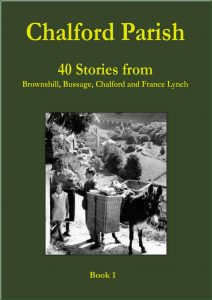 We had a very useful session when those members present were able to exchange ideas and sources for chapters in our upcoming book Chalford Parish in 40 Stories (working title).
We had a very useful session when those members present were able to exchange ideas and sources for chapters in our upcoming book Chalford Parish in 40 Stories (working title).
21st June 2017
Tina Indge: What did you do in the War?
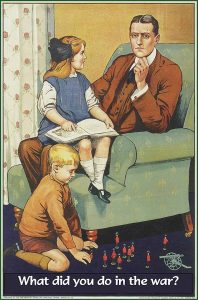 Despite the hot weather, more than two dozen (including guest Derelie Cherry from Tasmania!) enjoyed Tina’s illustrated talk. Using her personal researches into the lives of members of her family in WWI but mainly during WWII, Tina outlined the methods she had used from online sources as well as visits to The National Archives and the Royal Engineers’ Regimental Museum. She made it clear that stories from the family are not always to be fully trusted! Mention of the bombing of the Ransome and Marles ball bearing factory in Newark reminded members of local connections with Hoffman’s in Stonehouse.
Despite the hot weather, more than two dozen (including guest Derelie Cherry from Tasmania!) enjoyed Tina’s illustrated talk. Using her personal researches into the lives of members of her family in WWI but mainly during WWII, Tina outlined the methods she had used from online sources as well as visits to The National Archives and the Royal Engineers’ Regimental Museum. She made it clear that stories from the family are not always to be fully trusted! Mention of the bombing of the Ransome and Marles ball bearing factory in Newark reminded members of local connections with Hoffman’s in Stonehouse.
17th May 2017
Alexia Clarke: Stroud’s Museum in the Park and its Chalford connections
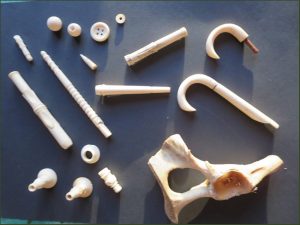 Alexia, who is the Documentation and Collections Officer at the Museum, outlined how it had started in 1890 in the School of Art and Science in Lansdown, moving to its current site in 2001. Items donated from the Chalford area include the 1862 regulations of the House of Mercy at Bussage, and numerous objects collected by William Edward Duncan Young (who for a time ran a museum at the Roundhouse). Alexia brought with her a diverse range of objects from the Chalford area, from a mammoth tooth, to a parasol handle, to a drag for pulling people/bodies out of the canal. We enjoyed trying to work out what they all were – and one at least remains a mystery object!
Alexia, who is the Documentation and Collections Officer at the Museum, outlined how it had started in 1890 in the School of Art and Science in Lansdown, moving to its current site in 2001. Items donated from the Chalford area include the 1862 regulations of the House of Mercy at Bussage, and numerous objects collected by William Edward Duncan Young (who for a time ran a museum at the Roundhouse). Alexia brought with her a diverse range of objects from the Chalford area, from a mammoth tooth, to a parasol handle, to a drag for pulling people/bodies out of the canal. We enjoyed trying to work out what they all were – and one at least remains a mystery object!
19th April 2017
Clive Field: The History of the Cotswold Canals.
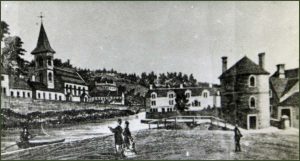 Clive Field outlined how the Stroudwater Navigation (up to Wallbridge) and the Thames and Severn Canal (Stroud to Lechlade) were completed in 1779 and 1789 respectively. Initially they were highly profitable enabling coal, grain and other items to be brought in, and wool to be taken out. The Costwold Canals Trust has enabled the restoration of much of the western end of the canal. He outlined the challenges and progress from Stonehouse to Brimscombe, illustrating the range of bridges and features restored.
Clive Field outlined how the Stroudwater Navigation (up to Wallbridge) and the Thames and Severn Canal (Stroud to Lechlade) were completed in 1779 and 1789 respectively. Initially they were highly profitable enabling coal, grain and other items to be brought in, and wool to be taken out. The Costwold Canals Trust has enabled the restoration of much of the western end of the canal. He outlined the challenges and progress from Stonehouse to Brimscombe, illustrating the range of bridges and features restored.
15th March 2017
Mike Mills: Photographs of Old Chalford Vale.
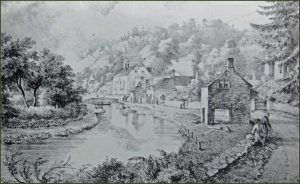 Using his great collection of old photographs, Mike Mills took us on a ‘walk’ from St Mary’s Mill all the way to Ashmeads Mills, where Mike himself grew up. Several well known local characters also appeared in some pictures.
Using his great collection of old photographs, Mike Mills took us on a ‘walk’ from St Mary’s Mill all the way to Ashmeads Mills, where Mike himself grew up. Several well known local characters also appeared in some pictures.
15th February 2017
Inspiring local research: led by members to stimulate interest in research and writing chapters for our new book, Chalford Parish in 40 Stories.
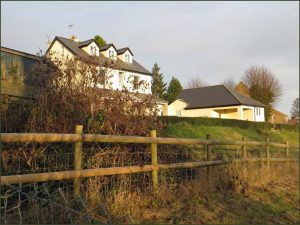 Roger Carnt talked about how he had set about researching the history of ‘The Limes’ – both the people and the property. He used a range of sources: maps (see National Library of Scotland and Coaley.net), Findmypast (includes many newspapers), Ancestry and Gloucestershire Archives.
Roger Carnt talked about how he had set about researching the history of ‘The Limes’ – both the people and the property. He used a range of sources: maps (see National Library of Scotland and Coaley.net), Findmypast (includes many newspapers), Ancestry and Gloucestershire Archives.
Jim Bocock spoke about his research into France Lynch Pleasure Ground and the YMCA hut that was built there, and Hilary Burgess spoke about her research on the Chalford Weavers’ strike of 1825, using published accounts. We explored members’ ideas for research, some of which will be worked into chapters for the planned book Chalford Parish in 40 Stories. Many exciting ideas were discussed for chapters in the book. To register a new topic or idea please use the Contact Form.
18th January 2017
Peter Waals and his craftsmen: The Chalford – Oakridge Link.
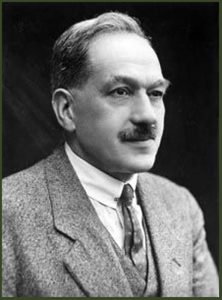 Jenny Bailey explained how Ernest Gimson and the Barnsley brothers, based at Pinbury Park, developed architectural work and furniture making in the Arts and Crafts tradition. In 1901 they moved to Sapperton and recruited Dutchman Peter Waals as their foreman. When Gimson died in 1919 the workshop moved to Hallidays Mill in Chalford and Waals lived in Chestnut House. Boys were recruited from local schools as apprentices and trained up to become skilled craftsmen. Ernie Smith became the foreman, and lived on Marle Hill. Examples of their work can be seen in Chalford Church, Rodmarton Manor, and St Michael and all Angels in Brownshill.
Jenny Bailey explained how Ernest Gimson and the Barnsley brothers, based at Pinbury Park, developed architectural work and furniture making in the Arts and Crafts tradition. In 1901 they moved to Sapperton and recruited Dutchman Peter Waals as their foreman. When Gimson died in 1919 the workshop moved to Hallidays Mill in Chalford and Waals lived in Chestnut House. Boys were recruited from local schools as apprentices and trained up to become skilled craftsmen. Ernie Smith became the foreman, and lived on Marle Hill. Examples of their work can be seen in Chalford Church, Rodmarton Manor, and St Michael and all Angels in Brownshill.
Waals, who taught at Brimscombe Polytechnic died in 1937 and is buried in the churchyard at Christ Church. The workshop moved across the road into Cotswold Works, but a year later this was destroyed by fire and the craftsmen were dispersed.

